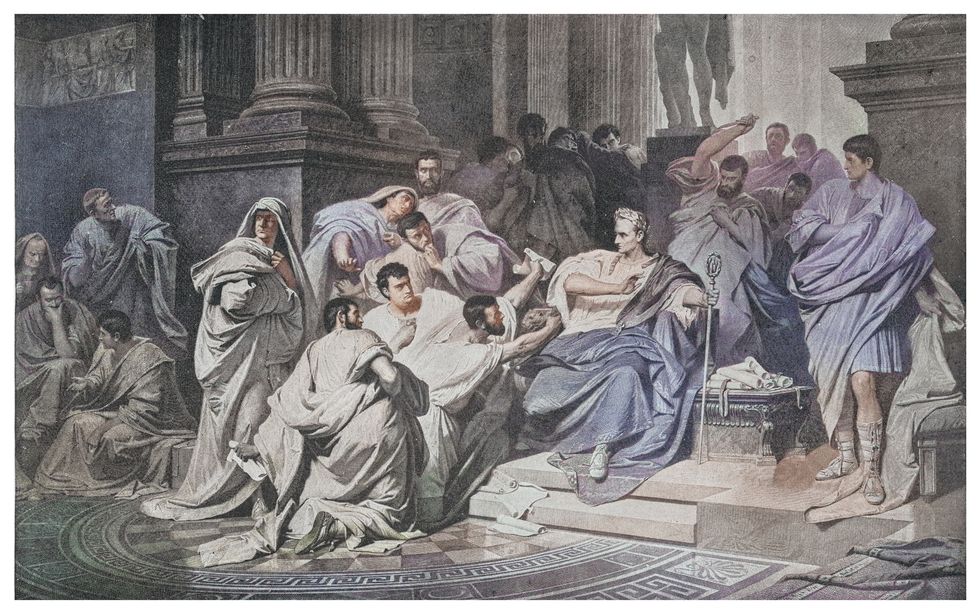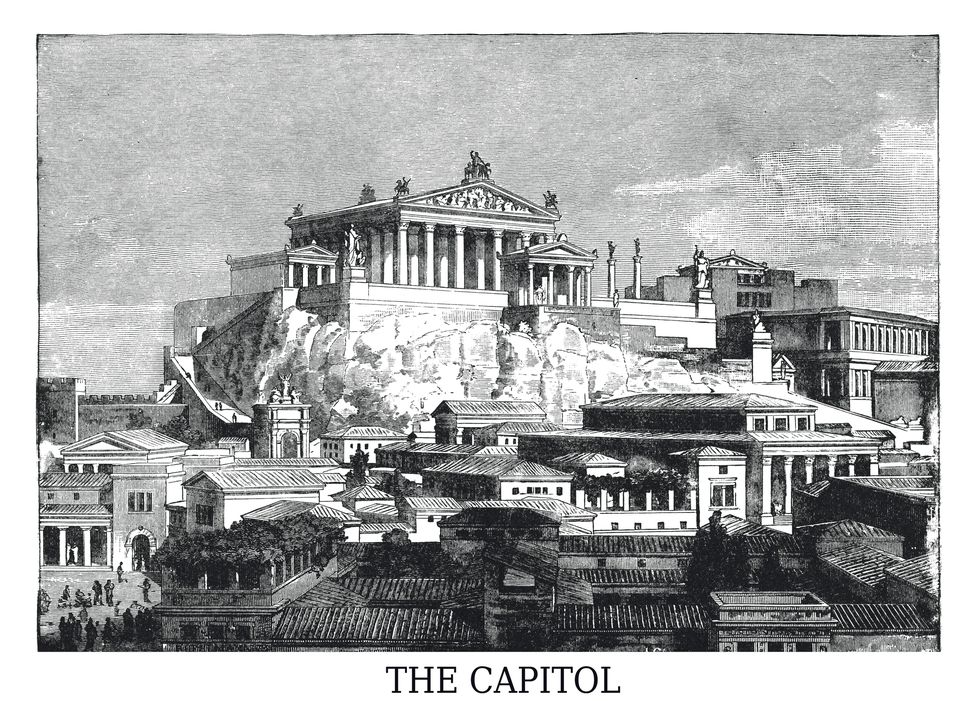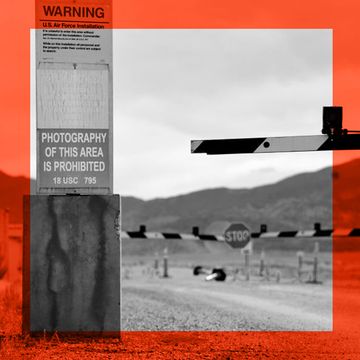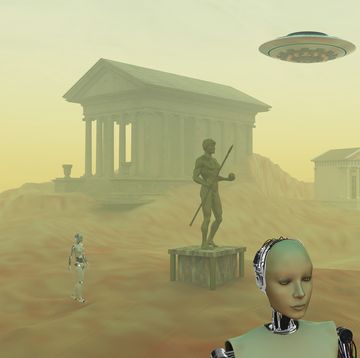- An abrasive TikTok user has claimed that the Roman Empire was never real.
- A papyrus scrap that the conspiracy theorist dismissed as Greek is actually a very famous Latin poem about Caesar.
- The TikTok user deleted her original account, but she still talks about Rome on her other accounts.
A TikTok contrarian once made waves with a bold claim that the Roman Empire wasn’t real—something she later tried to walk back by saying her original video was just a “metaphor.” But her timelines and writings are full of strong claims about ancient Rome, with just enough factual evidence that she might seem credible.
To be clear, the Roman Empire was real, and acknowledging the evidence and impact of that period of rule is vital to the histories of people the ancient Romans subjugated over a millennium.
Here’s everything you need to know about the intellectually dangerous Roman Empire conspiracy theory—and why you should remain vigilant while assessing claims made on social media.
“Dude, That’s Greek”
In one now-deleted video, writer Donna Dickens—who goes by @momllennial_ and @momllennial_returns on TikTok, and @MildlyAmused before she was suspended from Twitter—shows a very famous poem fragment variably known as the Gallus fragment, the Gallus papyrus, or the Qasr Ibrim papyrus. Gallus is the poet whose work is shown on the fragment, while Qasr Ibrim is the archaeological dig where the fragment was unearthed in modern-day southern Egypt. (Amazingly, the papyrus fragment and its environs survived not just thousands of years of wear and tear, but also the area’s flooding after the construction of the Aswan Dam.)
In her video, Dickens insists: “Dude, that’s Greek. Are y’all blind? Just, like, all of you?” Dickens’ video has been deleted, but her claim, like the papyrus, survives on. Maxwell Paule, a Roman classicist who teaches ancient and classical studies at Earlham College in Indiana, included it in a response video on his TikTok. “This is the Qasr Ibrim papyrus, and it’s really famous, and it’s definitely written in Latin. But you can read that yourself,” Paule explains in the video. “‘Maxima romanae’: it doesn’t get more Latin than that.”
I’m no expert, but I can do some basic comparative literature. I plugged into Google Translate the short phrases Paule identifies in his video, and “Fata mihi Caesar, . . . Maxima Romanae” translates to, “fate for me is Caesar, the greatest of the Romans.” It’s written in Latin script, meaning the same letters used in English. If I translate that into Greek, it comes out in Greek script as, “η μοίρα για μένα είναι ο Καίσαρας, ο μεγαλύτερος των Ρωμαίων,” which transliterates into Latin script as something like, “h moira gia mena einai o Kaisaras, o megalyteros twn Rwmaiwn.”
In other words, the language isn’t similar to what we see in Latin on the papyrus fragment, and you can’t really confuse the Latin alphabet with the Greek alphabet or transliteration.
The Danger of Partly Understood Science
Dickens’ LinkedIn page lists her education as a bachelor’s degree in anthropology, and she’s made her living as a writer covering popular culture like movies. Despite Dickens’ missteps, there’s absolutely such a thing as an outsider scholar: someone who is self-taught and doesn’t learn within traditional academia in the form of a history Ph.D. or other formal credential, and that’s especially true in the classics. “If a straggler supposed to understand Latin happened to sojourn in the neighborhood, he was looked upon as a wizard,” Abraham Lincoln wrote in 1834.
Lincoln’s father was self-taught, and Lincoln taught himself enough to become the only U.S. President ever to hold a patent. And there are countless autodidacts from all times in human history, although Lincoln was more on the end with virtually no formal education; today, the term is used for people like Steve Jobs, who dropped out of college, but had 12 years of schooling before then. The greatest autodidact of all time, depending on who you ask, may be Srinivasa Ramanujan. This astonishing man came up with thousands of valid mathematical ideas during his studies that were almost completely separate from the establishment.
But lying on Tiktok isn’t really the equivalent of a river-boating patent or a theorem on infinite series.
Debunking the Roman Empire Conspiracy Theory
Dickens relies on different forms of this same claim a lot: that things we think are Roman are really Greek, Etruscan, Phoenician, and so forth. But that claim itself is silly to the point of meaninglessness when it comes to the idea of an empire. At one point in time, the British Empire was the largest and richest empire to ever exist, and the people in it were considered British even while they were also Indian or Canadian.
Technology is one of the spoils of colonization. Calling these things Roman is not contrary to their parallel identity from another group. And erasing that dual identity doesn’t serve the historical record, especially for the people whose work was subjugated in the first place. What happened to them should be preserved. Hadrian’s Wall is the real work of the Romans, who were reeling from rebellions in ancient Britannia like that of the ancient Celtic queen Boudica. The British part of the history leads directly to the Roman part, and they inform one another.
Dickens also relies on claims about scientific studies, like the presence or lack of carbon dating of certain artifacts or human remains. This, Paule explains, is overly single-minded within the scope of history and archaeology. (And for me, as someone who covers the science side, the process of radiocarbon dating is “destructive,” meaning it uses a tiny amount of the material in question that must be destroyed in order to get the test results. There’s not always a lot to spare, or people who feel good about destroying a sample.)
“There are other ways of dating things beyond the one thing Donna is obsessed with,” Paule tells Popular Mechanics. “There are people who study paleography and can determine the date of things based on the shape of letters. [C]ertain words in Latin go through different spellings and usages, so texts will have certain archaisms that fell out of use in certain periods. [And that’s] beyond the archaeological work, which is, Where did you find this, what geographical layer did you pull it out of?”
I asked Paule for an example of a scandal that has really rocked the world of classical studies, and he cited the revelation that a former Oxford scholar had trafficked fake Dead Sea Scrolls papyrus fragments to Hobby Lobby’s Museum of the Bible. (This sounds like a modern American life bingo card, but it’s real. The news broke in March 2020, and was likely eclipsed by the pandemic.)
The Verdict
This is not to say that everything Dickens puts out there is wrong. One thing she repeats around her social media accounts is that the Fascist regime of Benito Mussolini did a massive historical refresh on the idea of the ancient Roman Empire.
It’s absolutely true that Mussolini was obsessed with ancient Rome, and his Fascist party and regime were named for the ancient Roman symbol of justice and punishment known as the fasces. (The Lincoln Memorial is marked by two nonviolent fasces on Lincoln’s chair, and two classic fasces with axes elsewhere on the monument grounds.) To this day, white supremacist groups and other fascists continue to use ancient Roman symbols.
“If Italian Fascism has taught us anything, it is that the appropriation of ancient history provides these groups with a false origin story and a sense of authority to use violence that they cannot rightly claim and should never be given,” historian Sarah E. Bond of the University of Iowa wrote in 2018.
The problem is that Dickens’ half-cocked mistranslation, or any other misleading claim, is taking a page from the same playbook. When we debunk, we still need to preserve the materials and observations that correspond to reality. Otherwise, it’s really just bunk.

Caroline Delbert is a writer, avid reader, and contributing editor at Pop Mech. She's also an enthusiast of just about everything. Her favorite topics include nuclear energy, cosmology, math of everyday things, and the philosophy of it all.















